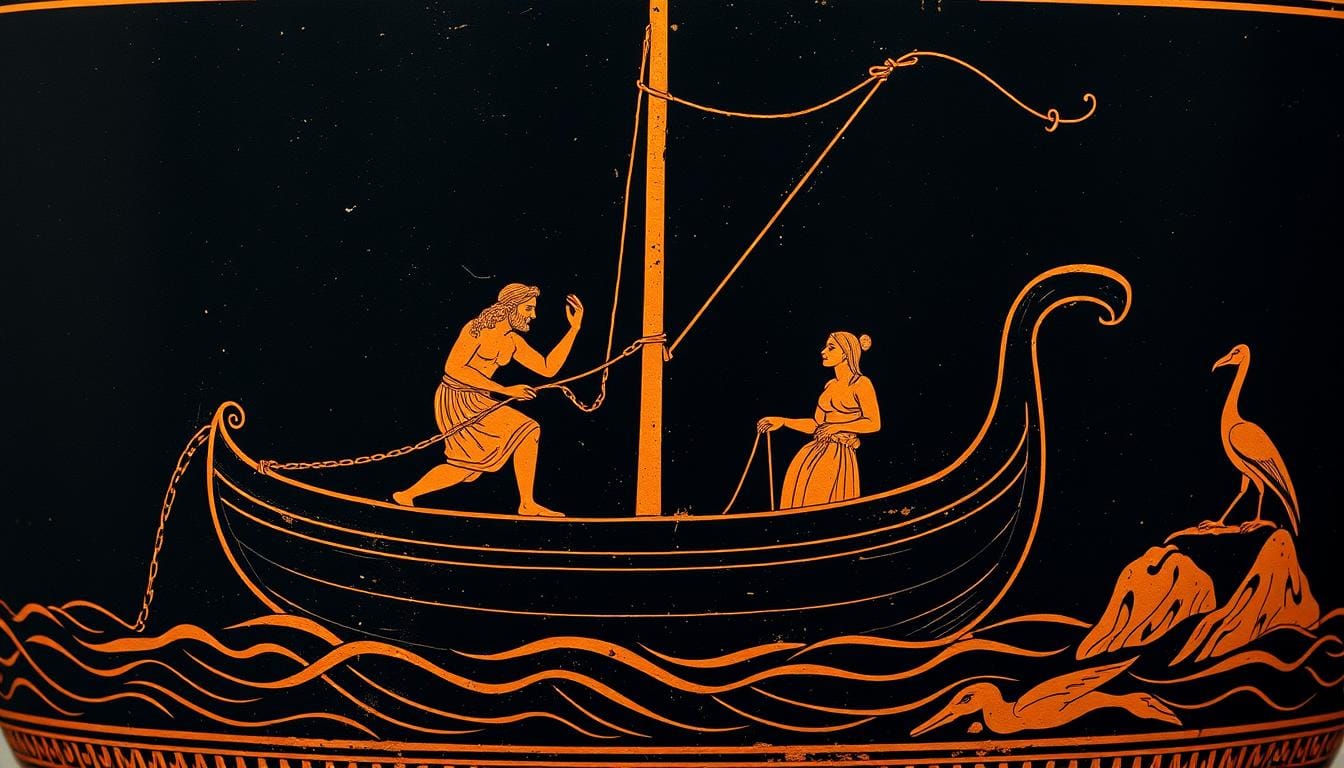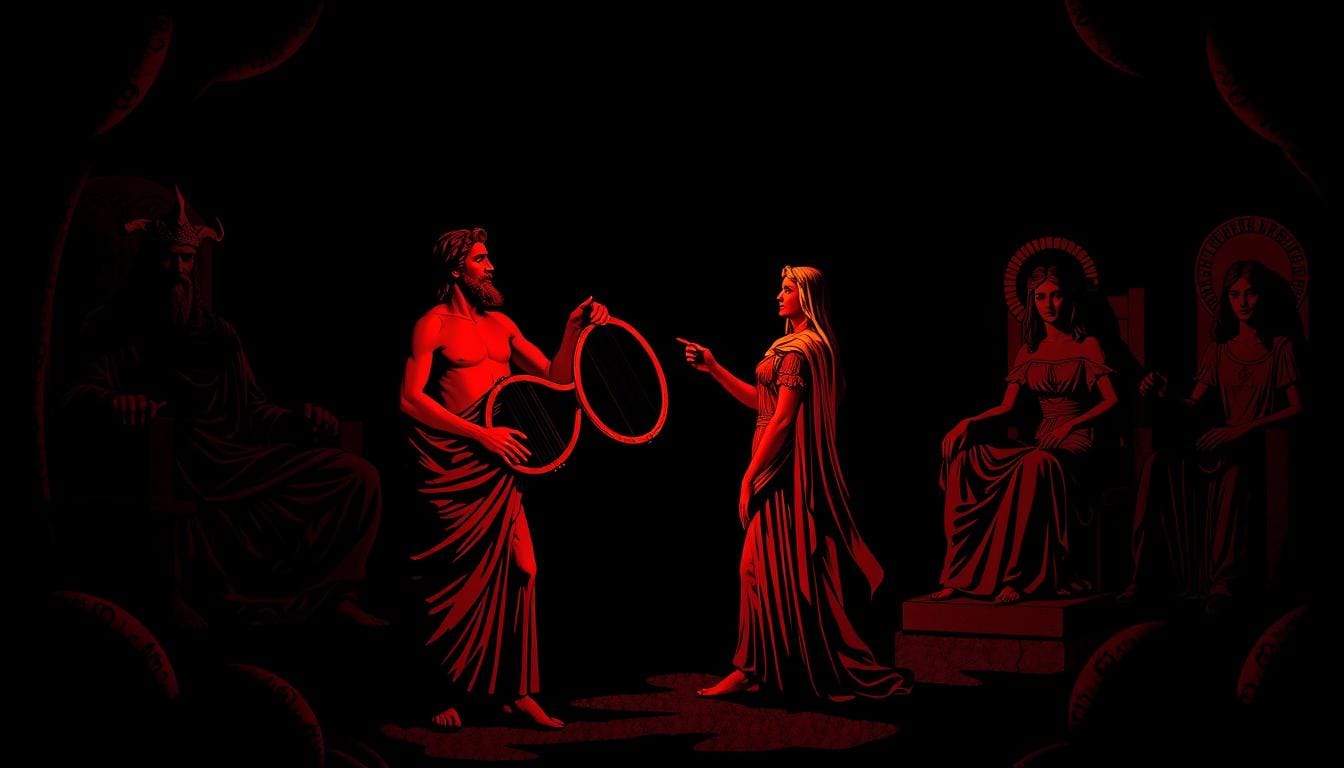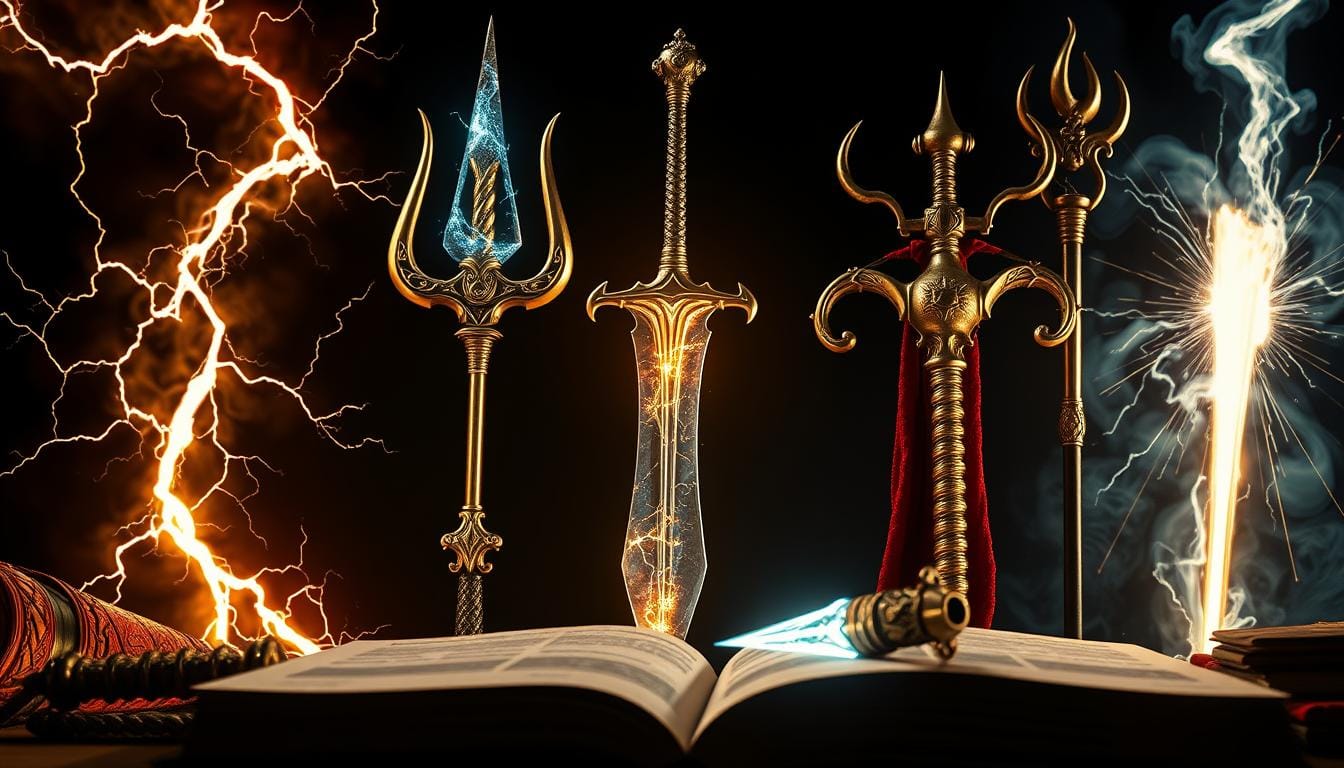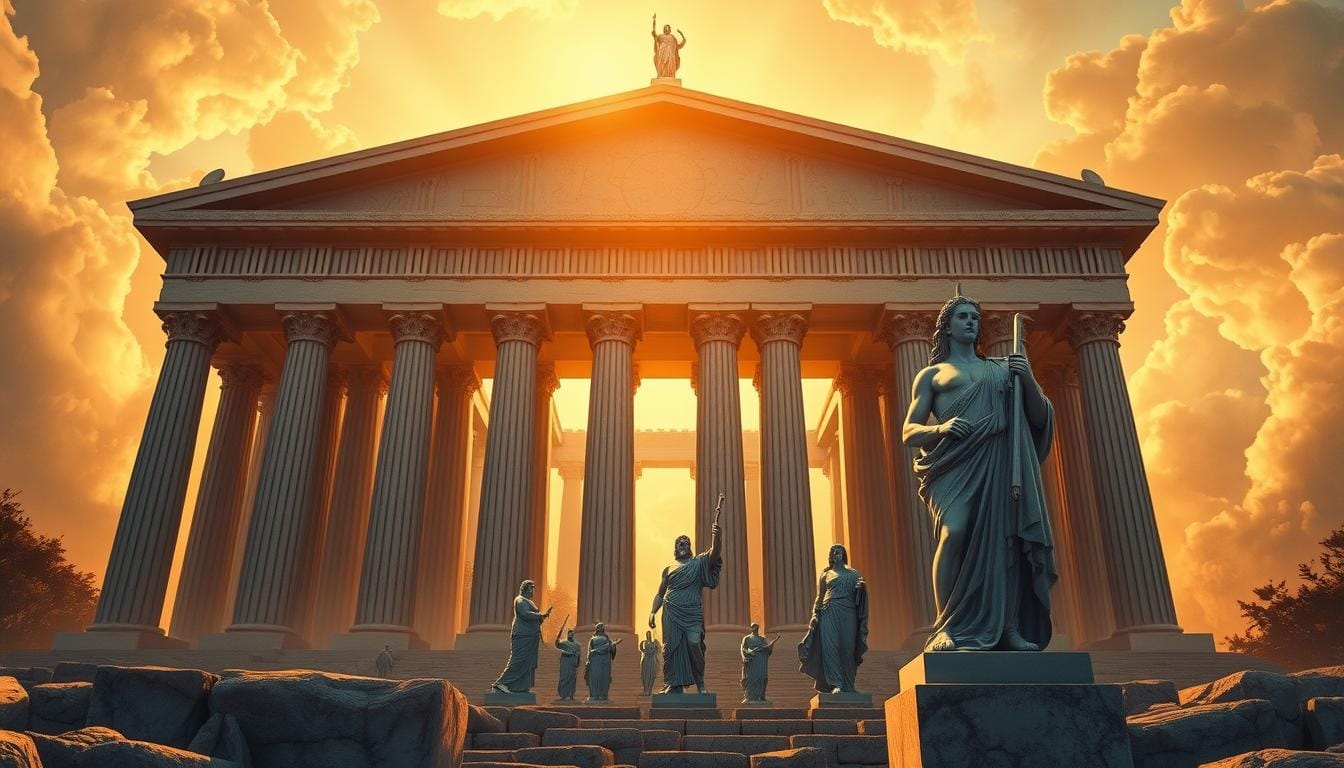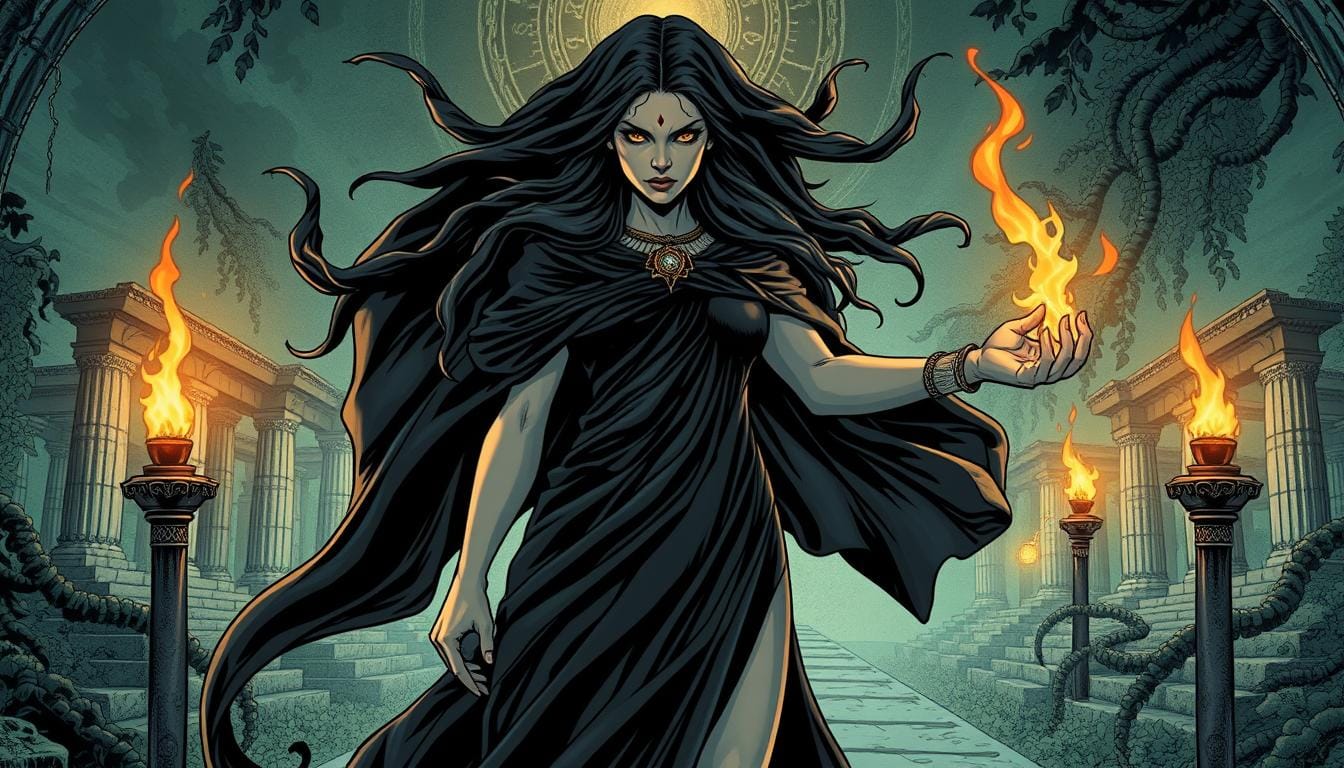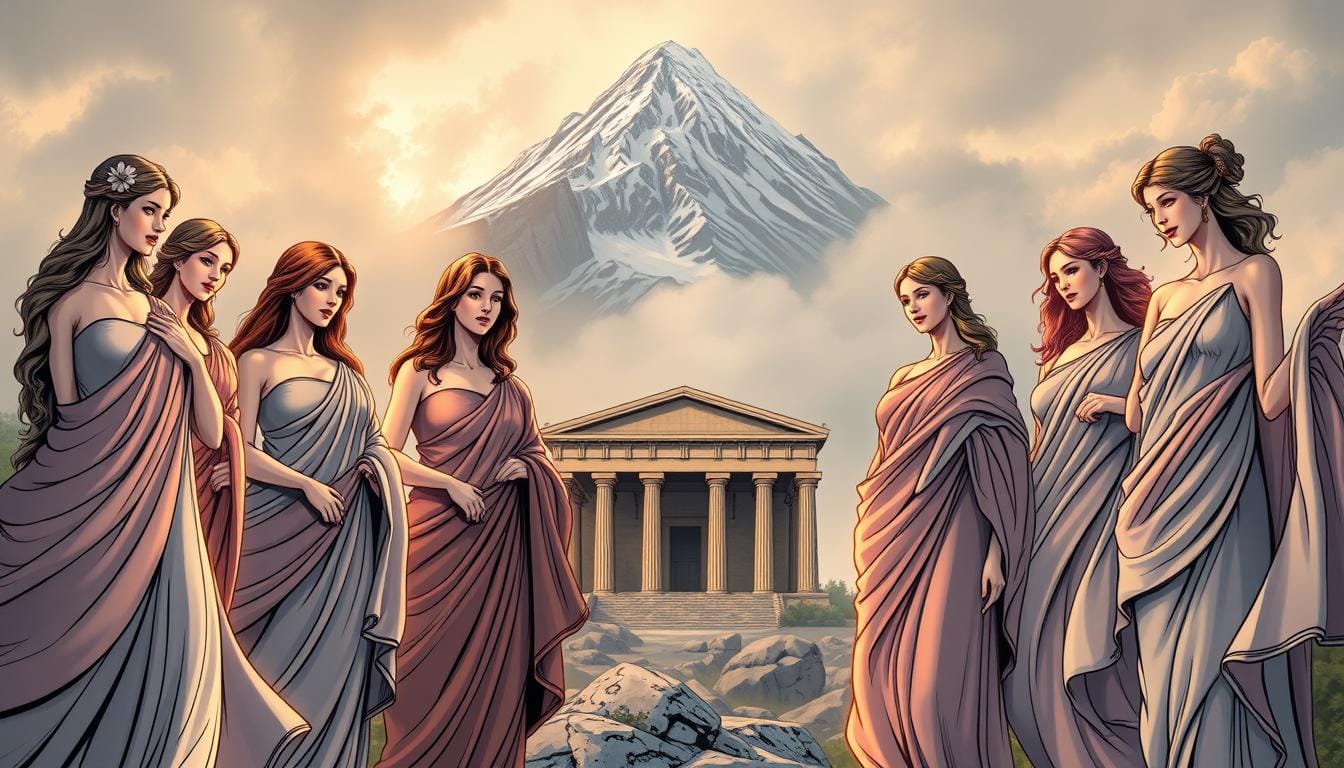Did you know that 95% of ancient civilizations would have faced complete collapse without the favor of a single divine figure? This staggering reality shaped the lives of millions across the Mediterranean world.
Meet Demeter, one of the most essential deities in Greek mythology. She controlled the very foundation of human survival through her dominion over agriculture and grain production. Ancient peoples understood that their existence depended entirely on her blessing of the earth’s bounty.
This powerful harvest goddess did more than simply grow crops. She governed the eternal cycle of seasons that determined life and death for entire communities. Her influence extended beyond agriculture into the spiritual realm, where she offered initiates a path to eternal bliss.
Her story weaves together themes of motherhood, loss, and renewal. These elements continue to resonate with people today, making her one of the most relatable figures from ancient times.
Key Takeaways
- Demeter controlled agriculture and grain production, making her essential for human survival in ancient times
- She governed seasonal cycles that determined the success or failure of entire civilizations
- Her mythology encompasses powerful themes of motherhood, loss, and natural renewal
- She presided over Mystery Cults that promised initiates a blessed afterlife
- Her influence extended beyond farming into spiritual and cultural practices
- Ancient communities depended on her favor for their very existence
Introduction to Demeter and Her Significance
The goddess Demeter was more than just a figure for crops and grain to the ancient Greeks. She was the foundation of civilized life. This seasonal deity controlled harvests and the survival of people. Her influence reached into health, marriage, and the mysteries that connected mortals to the divine.
As one of the twelve Olympian gods, Demeter was very important. Unlike other gods, she directly affected daily life. Every meal, season, and agricultural cycle was under her control.
Overview of Greek Mythology
Greek mythology explained the world’s mysteries. It helped people understand nature, society, and morals. The gods were not distant but involved in human lives.
Demeter had a special place in Greek mythology. She connected the divine world of Mount Olympus to the earthly concerns of farmers and families. Her stories taught about loss, renewal, and life’s cycles.
The Greeks saw their gods as part of complex families and hierarchies. Demeter’s role as both sister to Zeus and mother to Persephone made her central to many myths. These stories shaped their views on power, family, and nature.
| Aspect of Demeter | Mythological Role | Cultural Impact | Modern Relevance |
|---|---|---|---|
| Harvest Goddess | Controlled crop success | Determined survival | Agricultural awareness |
| Mother Figure | Protected Persephone | Family relationships | Parental devotion |
| Seasonal Deity | Created winter/spring cycle | Explained natural changes | Environmental cycles |
| Civilizing Force | Taught agriculture | Enabled settled communities | Sustainable farming |
Importance of Harvest in Ancient Greece
Ancient Greek society relied on successful agriculture to survive. Without good harvests, famine, unrest, and death followed. Demeter was both feared and revered for this reason.
The Mediterranean climate posed challenges to Greek farmers. Unpredictable rainfall, harsh summers, and rocky soil made farming hard. Success needed divine favor from Demeter.
Greek communities held festivals to honor Demeter and ensure her favor. The Thesmophoria, Eleusinian Mysteries, and other celebrations combined worship with farming knowledge. These events strengthened community bonds and taught farming skills.
Agriculture allowed for the growth of permanent settlements. This mythological figure represented a key step in human development. Without her gifts, Greek city-states could not have thrived.
The economy of ancient Greece was built on agricultural surplus. Good harvests allowed for other occupations like craftsmanship, trade, and philosophy. Demeter’s influence touched every part of Greek culture and thought.
Demeter's Family and Relationships
Family was key to Demeter’s story, from her Titan roots to her love for Persephone. The Earth goddess came from a powerful line. Her family ties shaped her and the Greek gods.
Demeter was a Titan, born to Cronus and Rhea. She had a rich heritage and deep earth bonds. Her siblings were famous:
- Hestia – goddess of the hearth and home
- Hera – queen of the gods and goddess of marriage
- Hades – ruler of the underworld
- Poseidon – god of the seas
- Zeus – king of the gods
Family ties in the gods were complex. Each sibling was powerful. This made Mount Olympus lively.
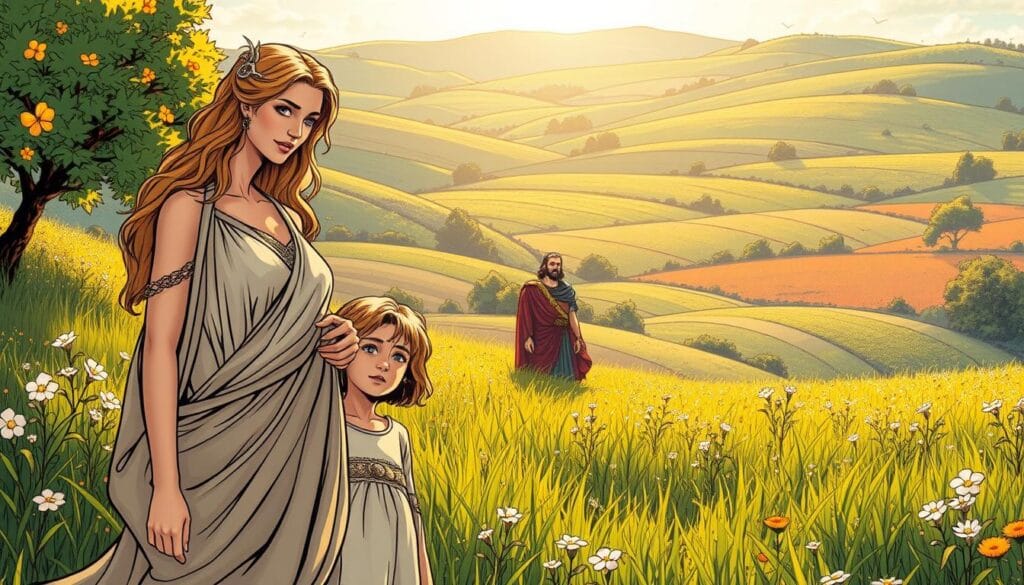
Beloved Daughter Persephone
Demeter and Persephone’s bond was strong. Persephone’s mother showed deep love. This love was central to their myth.
Persephone shared her mother’s fertility. She became a spring and renewal goddess. Their bond symbolized the seasons and growth.
Demeter’s love for Persephone was unmatched. When Persephone was in danger, Demeter’s reaction changed the world.
Complex Connection to Zeus
Demeter and Zeus’s relationship was complex. Zeus was her brother and king. Their union brought joy and sorrow for the Earth goddess.
Zeus’s decisions often affected Demeter. Their relationship showed loyalty and power struggles. Despite this, they respected each other’s domains.
Interactions with Other Divine Beings
Demeter’s encounter with Poseidon added to her family’s story. This led to Despoina and Arion. It showed the challenges faced by female deities.
Demeter worked with gods on earth matters. She formed alliances with minor deities and nature spirits. These partnerships ensured the earth’s fertility.
The Myth of Demeter and Persephone
The myth of Demeter and Persephone is a tale of love, loss, and nature’s cycles. It’s a story of a mother’s love and the changing seasons. The Homeric Hymn to Demeter tells this powerful story that has amazed people for thousands of years.
Demeter, the agriculture deity, kept the earth and sky in harmony. Her daughter, Persephone, was young and full of life, enjoying the beauty of nature. But their peaceful world was about to face a great challenge.
The Abduction by Hades
Persephone’s life changed on an ordinary day. She was picking flowers in a meadow, drawn to a beautiful narcissus. But this flower was a trap set by Hades, the lord of the underworld.
As Persephone reached for the flower, the earth opened. Hades, in his dark chariot, took her away. Her cries echoed across the land as she was dragged down into the underworld.
The abduction was so quick that even her friends couldn’t stop it. Only Helios, the sun god, saw the whole thing from above. The earth closed again, leaving no sign of what happened.
The Search for Persephone
When Demeter found out her daughter was gone, she was filled with grief. She left her duties and searched the world for nine days and nights. She called out for Persephone everywhere.
During her search, Demeter didn’t eat, drink, or bathe. Her sadness was so deep that she forgot her role as the harvest goddess. Crops began to wither and die.
Helios told Demeter the truth about Hades’ crime. Her anger shook Mount Olympus. She demanded justice from Zeus, but he had agreed to Hades and Persephone’s marriage.
Demeter’s anger grew when she found out Zeus had betrayed her. She stopped doing her divine work, causing a famine. People started to starve, and they stopped making offerings to the gods.
| Phase of Search | Duration | Demeter’s Actions | Earth’s Condition |
|---|---|---|---|
| Initial Search | 9 Days | Wandering and calling | Normal growth |
| Learning Truth | 1 Day | Confronting Helios | Crops begin failing |
| Divine Strike | Months | Refusing duties | Complete famine |
| Negotiation | Several days | Bargaining with Zeus | Gradual recovery |
The Reunion and its Significance
Zeus realized Demeter’s strike could harm all life. He sent Hermes to the underworld to bring Persephone back. Hermes found Persephone sitting by Hades’ throne, sad.
Hades agreed to let Persephone go, but with a trick. He offered her pomegranate seeds. Persephone ate four seeds, binding herself to the underworld forever.
The reunion brought joy to both Demeter and Persephone. But, a harsh reality remained. Persephone could never fully return to the upper world because she had eaten food in the underworld.
Zeus found a way to please everyone. Persephone would spend four months with Hades, for each seed she ate. The other eight months, she would be with her mother above ground.
This deal created the eternal cycle of seasons. When Persephone goes to the underworld, Demeter mourns and the earth becomes barren, leading to autumn and winter. When Persephone returns, Demeter’s joy brings back fertility to the land, ushering in spring.
The myth shows how emotional states affect nature. Demeter’s love for Persephone changes the world, showing the power of motherly love and the cycle of life.
Symbols Associated with Demeter
Demeter’s symbols were like a secret language for ancient people. They told stories without words, linking them to the harvest goddess in everyday life. Each symbol had deep meaning, showing the divine and earthly sides of Demeter.
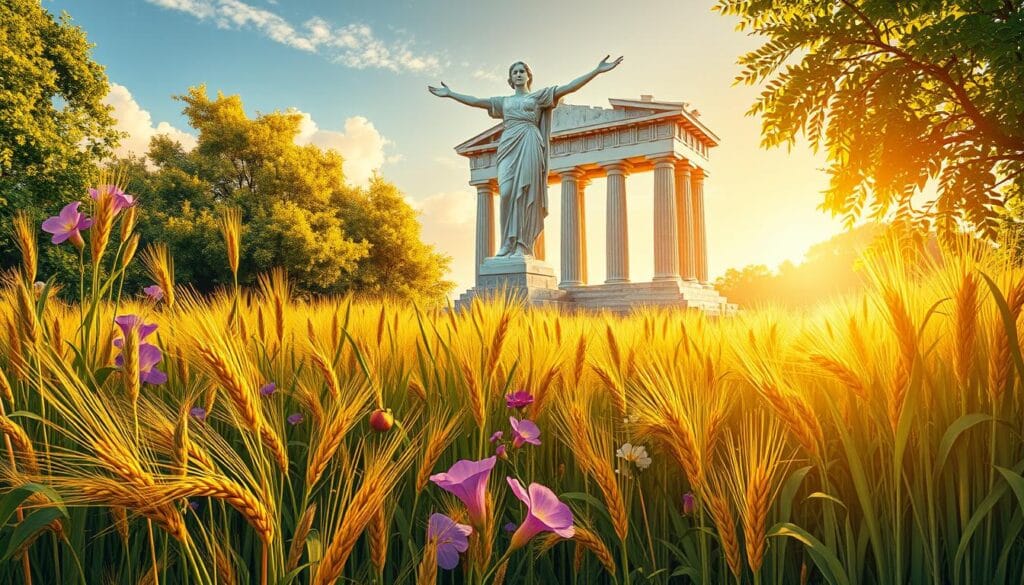
The Cornucopia
The cornucopia, or horn of plenty, is Demeter’s most famous symbol. It’s filled with fruits, veggies, and grains, showing her as the ultimate provider. Artists often showed the harvest goddess holding it, symbolizing endless abundance.
This symbol meant more than just food. It stood for wealth, luck, and the fruits of hard work. Farmers prayed to Demeter, hoping their harvests would fill such a magical horn.
Wheat and Grain
Wheat sheaves were Demeter’s clear and practical symbols in Greek mythology. They linked her to the bread that fed civilizations. These symbols were found on coins, pottery, and temple walls.
Barley and other grains were also sacred. Demeter taught humans to grow these crops, turning wild grasses into food. Grain symbols reminded people of Demeter’s role in civilization.
Other Nature Symbols
The bright red poppy was Demeter’s special flower, standing out in grain fields. It symbolized beauty and mystery, as well as sleep and dreams. Her torch, while searching for Persephone, meant hope and a mother’s love.
Her animals told parts of her story in Greek mythology. Pigs were symbols of fertility, often sacrificed at harvest festivals. Serpents represented the earth’s power and renewal. Owls and doves brought wisdom and peace.
Together, these symbols painted a full picture of the harvest goddess. They showed her as a nurturing mother and a powerful deity, linking farming with divine blessings.
The Role of Demeter in Agriculture
The agriculture deity Demeter was a divine protector and teacher for ancient Greek farmers. She influenced every part of farming, from planting to seasonal planning. The Greeks saw her as the ultimate farming wisdom source.
Demeter’s teachings were more than just growing crops. She laid the groundwork for organized farming that fed civilizations.
Influence on Farming Practices
Ancient farmers credited Demeter with teaching them the art and science of farming. She showed them how to plow and plant at the right times. She also taught about soil prep and crop rotation.
The goddess taught efficient harvesting methods too. Farmers learned to read natural signs for the best harvest times. These skills were passed down through generations.
Greek farmers developed advanced farming systems based on Demeter’s teachings. They knew which crops thrived in different soils and climates.
Festivals Celebrating the Harvest
The Thesmophoria festival honored Demeter’s role in fertility and farming. It was a celebration for women, sharing farming wisdom and celebrating harvests.
The famous Eleusinian Mysteries linked spiritual growth with farming knowledge. These rites promised deeper farming insights to followers. The seasonal deity shared secrets about crop timing and soil management.
| Festival | Purpose | Participants | Agricultural Focus |
|---|---|---|---|
| Thesmophoria | Fertility and farming techniques | Women only | Planting and soil preparation |
| Eleusinian Mysteries | Spiritual and agricultural wisdom | Initiated devotees | Crop cycles and timing |
| Lithobolia | Stone-throwing ritual | Community members | Protection of crops |
Connection with the Seasons
Demeter’s seasonal connection guided farmers all year. Her moods showed when to plant and when to rest. Farmers learned to work with nature’s cycles.
Spring was for planting, summer for tending, and fall for harvesting. Winter was for rest and planning. This seasonal wisdom helped farmers succeed.
“Understanding Demeter’s preferences was literally a matter of survival for ancient farmers, making her one of the most practically important deities in the Greek pantheon.”
Winter was for rest and planning for the next season. Demeter’s teachings created a sustainable farming system. This supported thriving communities.
Demeter in Art and Literature
Demeter’s artistic legacy spans millennia, inspiring creators across cultures and time. Her image is found in ancient sculptures and modern paintings. Artists see her as a symbol of abundance and maternal wisdom.
Writers and poets have woven her stories into epic tales and intimate verses. Her influence goes beyond ancient Greece to modern creative expressions. Today, artists find new ways to interpret her timeless themes.
Ancient Greek Artistic Representations
Ancient Greek artists depicted Demeter as a mature and dignified woman. She was seen as wise and nurturing, unlike other goddesses. Her art showed her as a protective mother and provider.
The famous sculptor Praxiteles created what many saw as the perfect Demeter. Sadly, these masterpieces have not survived. Yet, descriptions suggest they beautifully captured her essence.
Artists showed Demeter in various meaningful poses:
- Seated in maternal dignity – representing her nurturing nature
- Walking with purpose – during her search for Persephone
- Riding in chariots – drawn by horses or dragons, showing her connection to earth’s powers
Classical Literary References
Homer’s epic poems featured Demeter as both gentle nurturer and fierce protector. The Homeric Hymns dedicated sections to her stories and significance. These works highlighted her dual nature of kindness and wrath.
Classical authors showed her as capable of great compassion and anger. Her emotional range made her a compelling character. Writers used her story to explore themes of loss, hope, and renewal.
The earth goddess appeared in many plays and poems. Authors emphasized her connection to agricultural cycles and seasonal changes. These works helped spread her worship across the Mediterranean world.
Contemporary Artistic Interpretations
Modern artists see Demeter as a symbol of environmental protection and sustainable agriculture. Contemporary paintings often show her surrounded by abundant harvests or threatened landscapes. She represents humanity’s relationship with nature in an age of climate change.
Today’s interpretations focus on her relevance to current concerns about food security. Artists depict her as a guardian of the natural world and advocate for ecological balance. This mythological figure speaks to modern anxieties about environmental destruction.
Writers continue to retell her stories in novels, poetry, and screenplays. Her themes of motherhood, loss, and renewal resonate with contemporary audiences. Modern goddess worship movements have also adopted her as a central figure in their spiritual practices.
Celebrating Demeter Today
Today, people around the world celebrate Demeter’s legacy. They do this through festivals, spiritual practices, and efforts to support sustainable farming. Even though her temples in Megara are now ruins, her spirit lives on in our celebrations of the earth.
These modern celebrations remind us of the old days. Back then, people would offer pigs, bulls, honey-cakes, and fruits to honor Demeter’s gifts.
Harvest Festivals in Contemporary Times
In America, harvest festivals bring people together just like they did in ancient Greece. From small-town fairs to big agricultural shows, these events celebrate the harvest. County fairs, pumpkin festivals, and apple harvest celebrations are like the ancient Thesmophoria.
At these gatherings, you can see local produce, farming competitions, and community meals. Families enjoy corn mazes, hayrides, and seasonal activities. These activities connect them to farming traditions.
Gratitude and working together are key to these celebrations.
Modern Spiritual Practices
Neo-pagan and earth-based spiritual groups have found Demeter to be a powerful symbol. They honor natural cycles and seasonal changes with rituals. They celebrate the autumn equinox, harvest moons, and planting seasons with ceremonies that reflect ancient wisdom.
These practices focus on living in harmony with nature. People keep personal altars with grains, fruits, and flowers. Community gardens and sacred groves are like modern temples where people honor the harvest goddess and her teachings.
The Importance of Sustainable Agriculture
The movement towards sustainable farming shows Demeter’s wisdom about caring for the earth. Organic farming, permaculture, and regenerative agriculture follow her values. These methods prioritize soil health, biodiversity, and long-term care for the environment.
Community-supported agriculture, farmers’ markets, and farm-to-table restaurants honor Demeter’s love for local food. Urban gardening initiatives and rooftop farms bring farming to cities, connecting city folks to the land.
| Ancient Practices | Modern Equivalents | Shared Values |
|---|---|---|
| Thesmophoria festivals | Harvest festivals and county fairs | Community celebration of abundance |
| Temple offerings of grains | Farmers’ market displays | Gratitude for agricultural bounty |
| Sacred groves (Megara) | Community gardens and parks | Sacred connection to nature |
| Seasonal rituals | Earth-based spiritual practices | Honoring natural cycles |
Even small actions like growing herbs or vegetables connect us to Demeter’s lasting impact. These actions show that the harvest goddess is as relevant today as she was in ancient times. She inspires us to live sustainably and care for the environment.
Demeter's Influence on Culture
The goddess of harvest has made a big impact on today’s culture. She’s known from ancient Rome as Ceres to modern digital entertainment and spiritual practices. This mythological figure inspires creators and believers in many ways.
The Romans loved Demeter so much they renamed her Ceres. They made her key to their farming identity. This shows how Greek mythology can cross cultures and adapt to new societies.
Popular Media and Entertainment
Demeter is a big hit in books, movies, and video games today. In the Percy Jackson series, she’s a caring but strong mother. Her powers over nature make her both a friend and a foe.
Video games often show her as a nature goddess. She can heal or destroy based on how humans treat the earth. Comic books and graphic novels also use her to talk about environmental themes and feminine power. These stories keep the original myth alive for today’s readers.
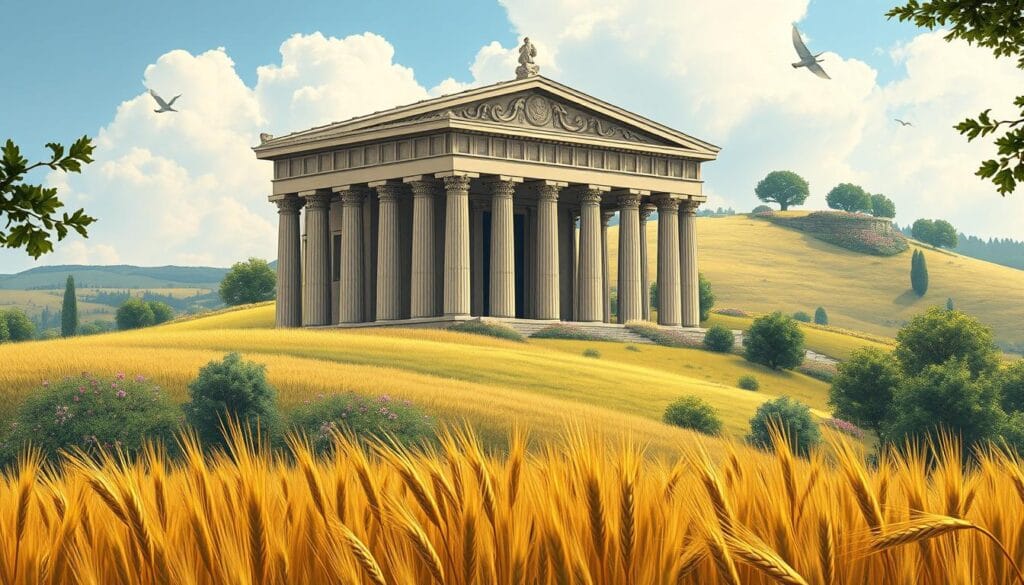
Literary and Theatrical Renaissance
Today’s books use Demeter’s stories in new ways. Authors link her myth to environmental issues and renewal. Her story with her daughter touches on themes of loss and reunion.
Theater shows also bring her stories to life. Directors find new meaning in her emotional journey. They focus on love, loss, and hope.
Writers see Demeter’s grief as connected to today’s problems like climate change. This shows how Greek mythology remains relevant today.
Modern Spiritual Movements
Goddess worship movements see Demeter as a symbol of feminine power and environmental activism. They connect her wisdom about earth’s cycles to today’s environmental issues. This shows her sacred feminine principle in nature.
Organic food movements look to her for inspiration in sustainable farming. Environmental activists invoke her name for protecting our planet. These modern views show Demeter’s lasting impact.
Feminist spirituality groups value her story for its message of maternal strength and nature’s power. They see her journey as a guide for personal growth and healing.
Lessons from Demeter's Myths
Demeter’s myths teach us about life’s patterns. Her stories with Persephone are timeless. They offer insights into human nature, relationships, and our connection to nature.
The earth goddess shows how myths guide us through life’s challenges. Her tales share truths about loss, hope, and renewal. These stories resonate with people everywhere and at all times.
Life Cycles and Change
Demeter’s myth teaches us that change is constant. Like seasons, we grow and rest. Her story shows that hard times are just transitions.
Persephone’s disappearance is a universal loss we all face. Yet, Demeter’s story tells us that renewal comes after darkness. Ancient philosophical writers saw Persephone’s journey as a symbol of the soul’s immortality.
This seasonal deity teaches us to accept life’s rhythms. Fighting change only causes suffering. Embracing it leads to growth and transformation.
The Importance of Relationships
The bond between Demeter and Persephone shows the power of family. Their love can change the world. When Persephone vanished, Demeter’s grief stopped plant growth on Earth.
This myth highlights the depth of parental love. It shows the lengths we’ll go to protect our loved ones. It teaches us that relationships are worth fighting for, no matter the odds.
The story also shows how separation can strengthen bonds. The reunion between mother and daughter is more precious because of their time apart.
Agricultural Gratitude
As an earth goddess, Demeter reminds us that our food doesn’t come by magic. Every meal connects us to the soil and nature. Her myths teach us to appreciate the systems that feed us.
The goddess teaches us to respect nature beyond just saying thank you. We are not separate from nature but connected through every breath and bite.
Demeter’s lessons encourage us to think about our impact on the environment. Her stories remind us that our emotional and spiritual well-being depends on a healthy relationship with the earth.
Conclusion: The Enduring Legacy of Demeter
The ancient goddess Demeter continues to influence our world. Her wisdom is as relevant today as it was in ancient times.
Reflection on Her Impact Today
Isocrates said Demeter gave us agriculture and the Mysteries. These gifts helped us live better lives and hope for the future. Her teachings are just as important now.
Environmental efforts and the farm-to-table movement find inspiration in Demeter. Climate activists also follow her warnings about nature’s balance. Her teachings are timeless.
The Continued Relevance of Harvest and Seasons
Demeter’s influence is seen in our daily lives. Food security is a pressing issue worldwide. Sustainable farming shows her wisdom in working with nature.
Her story teaches us about the importance of balance. As we navigate uncertain times, Demeter’s guidance is invaluable. Her legacy is felt in every harvest meal and changing season.
